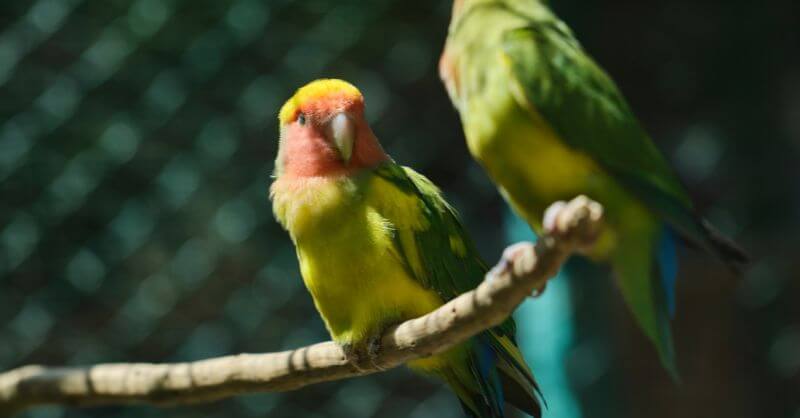Lovebirds are more outgoing and affectionate than parakeets. They are also more social and enjoy the company of other birds. Parakeets are more independent and aloof. They are still social birds, but they may not be as outgoing and affectionate as lovebirds.
Lovebirds are native to Africa while parakeets are native to Australia, and they are known for their colorful plumage and their ability to mimic human speech. They are also relatively quiet birds, which makes them a good choice for apartment dwellers.
Ultimately, the best pet for you will depend on your individual preferences. If you are looking for a bird that is cuddly and affectionate, then a lovebird may be a good choice for you.
If you are looking for a bird that is more independent and easy to care for, then a parakeet may be a better choice.
- Lovebirds vs. Parakeets: Longevity Affects Training Abilities
- Physical Characteristics of Lovebirds
- Physical Characteristics of Parakeets
- Behavior and Temperament of Lovebirds vs Parakeets
- Can lovebirds and parakeets live together?
- Comparison of lovebird and parakeet prices
- Diet of lovebirds and parakeets
- Intelligence Comparison: Parakeet vs. Lovebird
- FAQ
Lovebirds vs. Parakeets: Longevity Affects Training Abilities
- Lifespan: Parakeets typically live for 5-10 years, while lovebirds can live for up to 15 years. This means that lovebirds have more time to learn and develop their problem-solving skills.
- Training: Both parakeets and lovebirds can be trained, but lovebirds may be more responsive to training. This is because they are more intelligent and because they have a longer lifespan.

Physical Characteristics of Lovebirds
- Size and color variations: Lovebirds are small birds, typically measuring between 5 and 6.5 inches long. They come in a variety of colors, including green, yellow, blue, and orange. Some lovebirds also have distinctive heart-shaped face masks.
- Unique physical features: Lovebirds have a short, blunt tail and a stocky build. They also have a hooked beak and a zygodactyl foot, which means that two toes point forward and two point backward.
Physical Characteristics of Parakeets
- Size and color variations: Parakeets are also small birds, typically measuring between 4 and 6 inches long. They come in a variety of colors, including green, blue, yellow, white, and black. Some parakeets can also mimic human speech.
- Unique physical features: Parakeets have a long, pointed tail and a slender build. They also have a hooked beak and a zygodactyl foot.
| Feature | Lovebird | Parakeet |
| Size | 5-6.5 inches | 4-6 inches |
| Color | Green, yellow, blue, orange | Green, blue, yellow, white, black |
| Unique features | Heart-shaped face mask, short, blunt tail, stocky build | Long, pointed tail, slender build |
Behavior and Temperament of Lovebirds vs Parakeets
| Feature | Lovebird | Parakeet |
| Social behavior | Highly social | Less social |
| Bonding tendencies | Form strong bonds with owners | Less bonded to owners |
| Interaction with humans | Enjoys interacting with humans | Enjoys interacting with humans |
| Interaction with other birds | Good with other birds | Good with other birds |
| Playfulness | Very playful | Very playful |
| Vocalizations | Very vocal | Less vocal |
Can lovebirds and parakeets live together?
Lovebirds and parakeets can live together, but it is not always advisable. Lovebirds are more aggressive than parakeets, and they can sometimes bully or even injure parakeets.
If you are considering keeping lovebirds and parakeets together, it is important to make sure that the birds are compatible.

Considerations for introducing them to the same living space
If you do decide to introduce lovebirds and parakeets to the same living space, there are a few things you should keep in mind:
- Start slowly. Introduce the birds to each other gradually, and supervise them closely during their first interactions.
- Provide plenty of space. The birds should have plenty of space to avoid each other if they need to.
- Watch for signs of aggression. If the birds start to show signs of aggression, such as biting or lunging, separate them immediately.
Potential challenges and how to overcome them
- Aggression: As mentioned above, lovebirds can be aggressive towards parakeets. If you see any signs of aggression, separate the birds immediately.
- Barred cages: If you have a barred cage, make sure the bars are small enough so that the birds cannot get their heads stuck.
- Food and water bowls: Make sure the birds have separate food and water bowls. This will help to prevent them from fighting over resources.
Experiences of owners who have kept both species together
Many owners have successfully kept lovebirds and parakeets together. Here are some tips from owners who have kept lovebirds and parakeets together:
- Start by introducing the birds to each other in a neutral location. This could be a room that neither bird has been in before.
- Let the birds sniff each other through the bars of their cages. This will help them to get used to each other’s scent.
- Once the birds seem comfortable with each other, you can start to let them interact more closely. Supervise them closely during these interactions.
- If the birds start to fight, separate them immediately. Do not try to force them to get along.
Comparison of lovebird and parakeet prices
The price of lovebirds and parakeets can vary depending on the species, age, gender, and color. However, in general, lovebirds tend to be more expensive than parakeets.
| Species | Average Price |
| Lovebird | $50 – $200 |
| Parakeet | $20 – $100 |
Factors influencing the cost
The cost of lovebirds and parakeets is influenced by a number of factors, including:
- Species: Some species of lovebirds, such as Fischer’s lovebird, are more expensive than others.
- Age: Younger lovebirds and parakeets are typically more expensive than older birds.
- Gender: Male lovebirds are typically more expensive than female lovebirds.
- Color: Some colors of lovebirds and parakeets are rare and therefore more expensive.
- Availability: The availability of lovebirds and parakeets can also affect the price. If a particular species is in high demand, the price will be higher.
Availability in the pet market
Lovebirds and parakeets are both relatively common in the pet market. They can be found at most pet stores and bird breeders.
However, some species of lovebirds, such as Fischer’s lovebird, may be more difficult to find.
Diet of lovebirds and parakeets
Similar Diet
- Lovebirds and parakeets are both omnivores and their diet should be a mixture of seeds, fruits, and vegetables.
- They should both have access to a cuttlebone or mineral block to get the calcium they need.
- They should both have access to fresh water at all times.
Differences
- Lovebirds are prone to obesity, so it is important to feed them a balanced diet and limit their intake of fatty seeds.
- Parakeets are not as prone to obesity as lovebirds, but it is still important to feed them a balanced diet and limit their intake of fatty seeds.
Intelligence Comparison: Parakeet vs. Lovebird
Parakeets are considered to be moderately intelligent birds. They can learn to recognize their names, perform simple tricks, and even mimic human speech. They are also good at solving puzzles and finding food.
Cognitive abilities and problem-solving skills of lovebirds
Lovebirds are similar to parakeets in their ability to learn tricks and mimic human speech.
However, lovebirds are also known for their problem-solving skills. They can figure out how to open locks and solve other puzzles.
FAQ
What is the best cage for a lovebird or parakeet?
The best cage for a lovebird or parakeet is one that is at least 20 inches wide, 18 inches deep, and 18 inches tall. The cage should also have a variety of perches, toys, and food and water dishes.
What is the difference between a lovebird and a budgie?
A budgie is a type of parakeet, so there is not a huge difference between the two. However, lovebirds are slightly larger and have a more heart-shaped face mask.
Can a parakeet talk?
Some parakeets can learn to talk, but they are not as good at talking as some other types of parrots. However, they can still learn to say a few words or phrases.
Are lovebirds better than budgies?
Lovebirds are more outgoing and affectionate than budgies, and they are also slightly larger. However, they can be more difficult to tame, and they may be more demanding of attention.
Budgies are more independent and easygoing than lovebirds, and they are also slightly smaller. They are also easier to tame, and they may be less demanding of attention.
Should I get a lovebird or a parakeet?
This is a personal decision that depends on your individual preferences and lifestyle. Here are some factors to consider:
Size: Lovebirds are slightly larger than parakeets, so you will need a larger cage if you choose a lovebird.
Personality: Lovebirds are more outgoing and affectionate than parakeets, so they may be a better choice if you are looking for a bird that will cuddle with you.
Care level: Both lovebirds and parakeets require daily care, but lovebirds may be slightly more demanding of attention.

I am a writer and blogger who is passionate about birds. I write to inspire and educate others about the beauty and importance of avian species in our ecosystem. I love to watch birds flying and taking their photographs to capture those memories.

